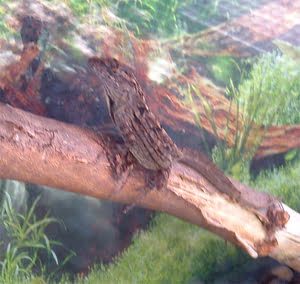Though I have seen these in the Petco I found no real information about them on the net, so my information came only from having my Bahaman anole as a pet.
I soon discovered that what I had was more commonly known as a BROWN anole (I guess the pet store thought “Bahaman” was the more interesting name) and there is some good information about them online.
Description: Much like the Green Anole, the Bahaman or brown anole has a slightly bulkier build. They are brown patterned and have a dewlap which, when flared, is a vibrant orange.
They can drop their tails if necessary and they do regenerate.
Their eyes are much like that of a chameleon’s, rotating the same curious way.
Though mine was wild-caught, I don’t believe these are really the type of pets you handle. Nonetheless, they are rewarding to watch.
Housing: I have kept Trayton (my anole) in a twenty gallon aquarium since I got him and have never had to clean it (save for washing down the sides once or twice). I’ve had him for about three years. He began bobbing his head about a year ago, which I’ve gathered is a sign of boredom (it can be in Iguanas) so I moved a couple of his branches around and he has stopped. Maybe in two more years I will have to do it again. 😉
I used aquarium pebbles for the flooring, with some coconut bark in some areas. A water bowl is a must as is daily spraying.
Because these guys seem to be so feisty, a screen top is helpful for pouring water into the bowl every time it empties. It is really hard to catch them if they get out!
60-80 degrees seems to be good. I have never used a real heat lamp, and my anole is healthy. He is by several windows though, so I would recommend some sort of “Vita-Light” if you are keeping one away from natural sunlight. I use a regular lamp with a fluorescent bulb for heat and on cold days, I leave the light on during the night as well.
A screen top is also good because the anole is able to leap up onto it and walk upside down beneath the lamp to get warm quicker!
Make sure he has plenty to climb around on!
Companions: I’m sure it would be safe to have one or two females with a male (watch for eggs!) in a 20 gallon tank, but I wouldn’t put two males together (especially after my cresteds fought).
I’ve seen several brown anoles packed together in goldfish-bowl sized tanks, but I will never follow that example!
Trayton currently lives with a smaller female green anole and they seem to get along great.
Bahaman anoles, green anoles, and long-tailed lizards all seem to be compatible. Just don’t overcrowd and I would try to only have one male in the bunch (or at least only one male of each kind).
Food: Crickets, earthworms, mealworms, waxworms, roaches and moths have all been happily consumed.
The above article was written from my personal experience observing and keeping a wild caught Bahaman Anole.
Note: The lizard is called the “Bahaman” anole, not the “Bahamian.” Both spellings mean the same thing. Though some may believe the former is incorrect, “Bahaman” is the spelling that the pet stores use.
